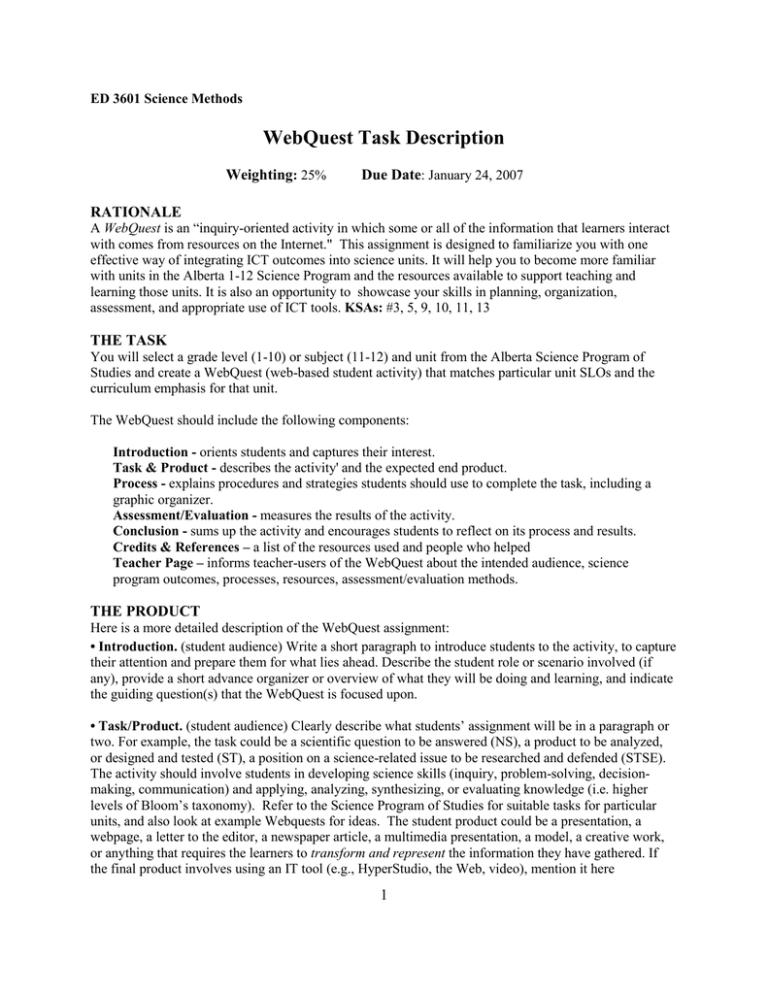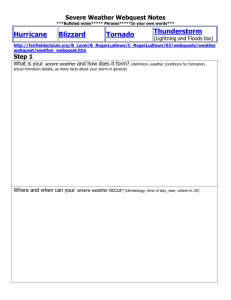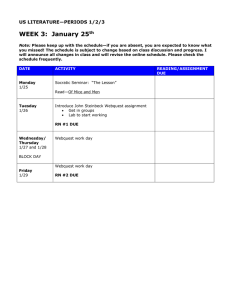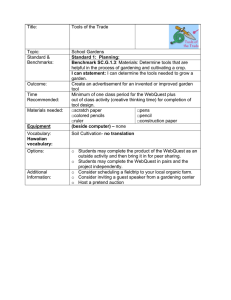WebQuest Task Description Weighting Due Date
advertisement

ED 3601 Science Methods WebQuest Task Description Weighting: 25% Due Date: January 24, 2007 RATIONALE A WebQuest is an “inquiry-oriented activity in which some or all of the information that learners interact with comes from resources on the Internet." This assignment is designed to familiarize you with one effective way of integrating ICT outcomes into science units. It will help you to become more familiar with units in the Alberta 1-12 Science Program and the resources available to support teaching and learning those units. It is also an opportunity to showcase your skills in planning, organization, assessment, and appropriate use of ICT tools. KSAs: #3, 5, 9, 10, 11, 13 THE TASK You will select a grade level (1-10) or subject (11-12) and unit from the Alberta Science Program of Studies and create a WebQuest (web-based student activity) that matches particular unit SLOs and the curriculum emphasis for that unit. The WebQuest should include the following components: Introduction - orients students and captures their interest. Task & Product - describes the activity' and the expected end product. Process - explains procedures and strategies students should use to complete the task, including a graphic organizer. Assessment/Evaluation - measures the results of the activity. Conclusion - sums up the activity and encourages students to reflect on its process and results. Credits & References – a list of the resources used and people who helped Teacher Page – informs teacher-users of the WebQuest about the intended audience, science program outcomes, processes, resources, assessment/evaluation methods. THE PRODUCT Here is a more detailed description of the WebQuest assignment: • Introduction. (student audience) Write a short paragraph to introduce students to the activity, to capture their attention and prepare them for what lies ahead. Describe the student role or scenario involved (if any), provide a short advance organizer or overview of what they will be doing and learning, and indicate the guiding question(s) that the WebQuest is focused upon. • Task/Product. (student audience) Clearly describe what students’ assignment will be in a paragraph or two. For example, the task could be a scientific question to be answered (NS), a product to be analyzed, or designed and tested (ST), a position on a science-related issue to be researched and defended (STSE). The activity should involve students in developing science skills (inquiry, problem-solving, decisionmaking, communication) and applying, analyzing, synthesizing, or evaluating knowledge (i.e. higher levels of Bloom’s taxonomy). Refer to the Science Program of Studies for suitable tasks for particular units, and also look at example Webquests for ideas. The student product could be a presentation, a webpage, a letter to the editor, a newspaper article, a multimedia presentation, a model, a creative work, or anything that requires the learners to transform and represent the information they have gathered. If the final product involves using an IT tool (e.g., HyperStudio, the Web, video), mention it here 1 ED 3601 Science Methods • Process (student audience) Describe the procedures in detailed numbered steps that students should use to complete the task. Include links to web resources that students will use, and details of print resources used for background information (e.g. read Science in Action 8, pp. 226-228). Also include guidance for students on how to organize information using graphic organizers such as flowcharts, summary tables, and concept maps. To scaffold student learning you may also wish to develop guide sheets with questions, hints, etc. • Evaluation. (student audience) Describe how students’ performance will be assessed/evaluated. Specify whether there will be a common grade for group work vs. individual grades, and include criteria for grading, and the scoring guide or checklist to be used for grading student products. • Conclusion. (student audience) Write a couple of sentences here that summarize what they will have learned by completing this WebQuest activity. You might also include some rhetorical questions or additional links to encourage them to extend their thinking into other content beyond this lesson. • Teacher Page. (teacher audience) Inform teacher-users about the intended audience, the relevant Alberta Science Program outcomes and other outcomes (e.g. ICT, math, social studies, ELA). Describe additional procedural details that a teacher would need, including suggestions for organizing groups, resources processes, anticipated problem areas, and materials and resources needed to implement the activity. Describe how the activity will be assessed and evaluated and additional details or clrifications about assessment/evaluation methods and tools. • Credit & References. List any books, other media and the sources of any images, music or text that you used. Provide links back to the original source. Say thanks to anyone who provided resources or help. SUBMISSION Webquests will be submitted electronically to the instructor by email or CD-ROM. WEBQUEST RESOURCES FOR TEACHERS • Kathy Schrock’s Guide for Educators: WebQuests http://school.discovery.com/schrockguide/webquest/webquest.html • WebQuest Page at San Diego State University (Bernie Dodge) http://webquest.sdsu.edu/ • Best WebQuests (Tom March) http://bestwebquests.com/ • WebQuest 101 Online Tutuorial http://www.teachersfirst.com/summer/webquest/quest-a.shtml • A WebQuest Template (the above format is based on this template) file:///Users/User/Desktop/lesson-template1/t-lesson-template1.htm 2


